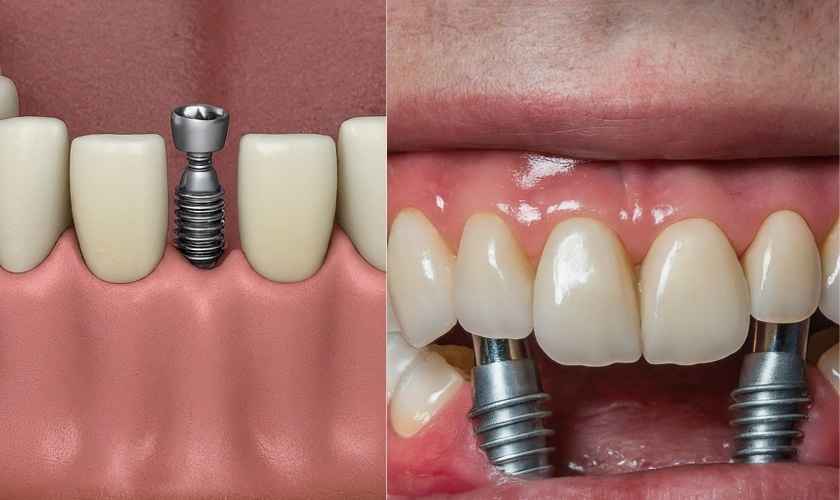Some Known Questions About Dental Sense.
Some Known Questions About Dental Sense.
Blog Article
The Single Strategy To Use For Dental Sense
Table of ContentsHow Dental Sense can Save You Time, Stress, and Money.How Dental Sense can Save You Time, Stress, and Money.Some Of Dental SenseThe Only Guide to Dental Sense
are medical tools operatively dental implanted right into the jaw to restore an individual's capability to eat or their appearance. They provide assistance for synthetic (fake) teeth, such as crowns, bridges, or dentures. When a tooth is lost as a result of injury or condition, an individual can experience difficulties such as fast bone loss, defective speech, or modifications to eating patterns that cause pain.Dental implant systems contain an oral implant body and oral implant abutment and might also include a joint addiction screw. Kids dental. The oral implant body is surgically inserted in the jawbone in place of the tooth's root. The oral implant joint is normally attached to the dental implant body by the joint addiction screw and expands through gum tissues into the mouth to sustain the attached synthetic teeth
(https://www.huntingnet.com/forum/members/dentalsense1.html)Structure of The Dental Implant System choosing dental implants, talk with your oral supplier about the potential advantages and threats, and whether you are a prospect for the procedure. Points to consider: Your overall wellness is an important consider figuring out whether you are a great candidate for dental implants, the length of time it will certainly take to recover, and for how long the implant may stay in area.
Cigarette smoking might affect the healing process and decrease the lasting success of the dental implant. The recovery process for the implant body may take numerous months or longer, throughout which time you generally have a short-lived joint in location of the tooth. the oral implant procedure: Carefully follow the dental health directions provided to you by your oral service provider.
What Does Dental Sense Mean?
Implant failure can result in the demand for another procedure to repair or change the dental implant system. Recovers the capability to chew Restores cosmetic look Helps keep the jawbone from reducing due to bone loss Protects the wellness of the surrounding bone and gum tissues Aids keep nearby (close-by) teeth stable Improves quality of life Damage to bordering natural teeth during dental implant placement Injury to the surrounding cells during surgical procedure, such as sinus opening Injury throughout surgery (for instance, crack of surrounding jawbone) Poor function, such as seeming like the teeth do not attack together generally A feeling that the tooth hangs or twisting in location arising from an abutment screw loosening Implant body failure (looseness of the implant body) due to systemic infection, which may be more probable in patients with uncontrolled diabetics issues due to regional infection in bone and gums sustaining the implant body because of postponed healing, which may be more most likely in clients that smoke Trouble cleaning the gum tissues around the dental implant, leading to inadequate oral health Untreated periodontal disease Post-surgical feeling numb as a result of nerve impingement or damage Always notify health treatment providers and imaging professionals that you have dental implants prior to any kind of magnetic resonance imaging (MRI) or x-ray treatments.
FDA is not familiar with any type of adverse events reported for MRI or x-ray procedures with dental implants. Dental implants systems are typically made of materials that adhere to worldwide consensus requirements of the International Organization for Standardization (ISO) or ASTM International. These criteria have information of what makes a risk-free material.

An oral implant is a framework that changes a missing tooth. With screw-like devices, the surgeon inserts an implant right into the jawbone, and it functions as a support for an artificial tooth, called a crown. A tool called a joint links the man-made tooth to the dental implant. The crown is personalized to fit the individual's mouth and match the shade of their teeth.
A Biased View of Dental Sense
Some individuals are not qualified for oral implant surgical treatment. It is for oral specialists to operate on individuals with: intense illnessuncontrollable metabolic diseasebone or soft cells disease or infectionIf these concerns are dealt with, an individual can have the surgical treatment. In, dental doctors refrain from operating individuals with: If individuals with any one of the above undergo dental implant surgical treatment, there is a greater threat of the dental implant failing.

Oral dental implant surgical treatment is a personalized process. It's not the very same for everyone. The following gives a basic review of what you can expect your dental professional, dental specialist, periodontist or prosthodontist to do: Position the implant surgically. Offer you time to heal. Connect the article and final crown, bridge or denture.
Next, your doctor will meticulously place the dental implant into your jaw. Your cosmetic surgeon will reposition your gums and close the cut with stitches. If your dental implant is near the front of your mouth, your dental expert will make a momentary tooth for you to use till you heal. By doing this, you will not have a gap in your smile while you recoup.
The Facts About Dental Sense Uncovered
Throughout the healing phase, your jawbone ought to fuse to the dental implant. This process can take anywhere from three to nine months.
Once your implant heals, your dentist can affix the abutment (little connector message) and your last remediation (crown, bridge or denture). This typically takes regarding one hour to complete and might call for a 2nd minor surgery. You should not really feel any pain throughout your dental implant treatment since your copyright will certainly make use of medicine to numb your gum tissues.
Report this page